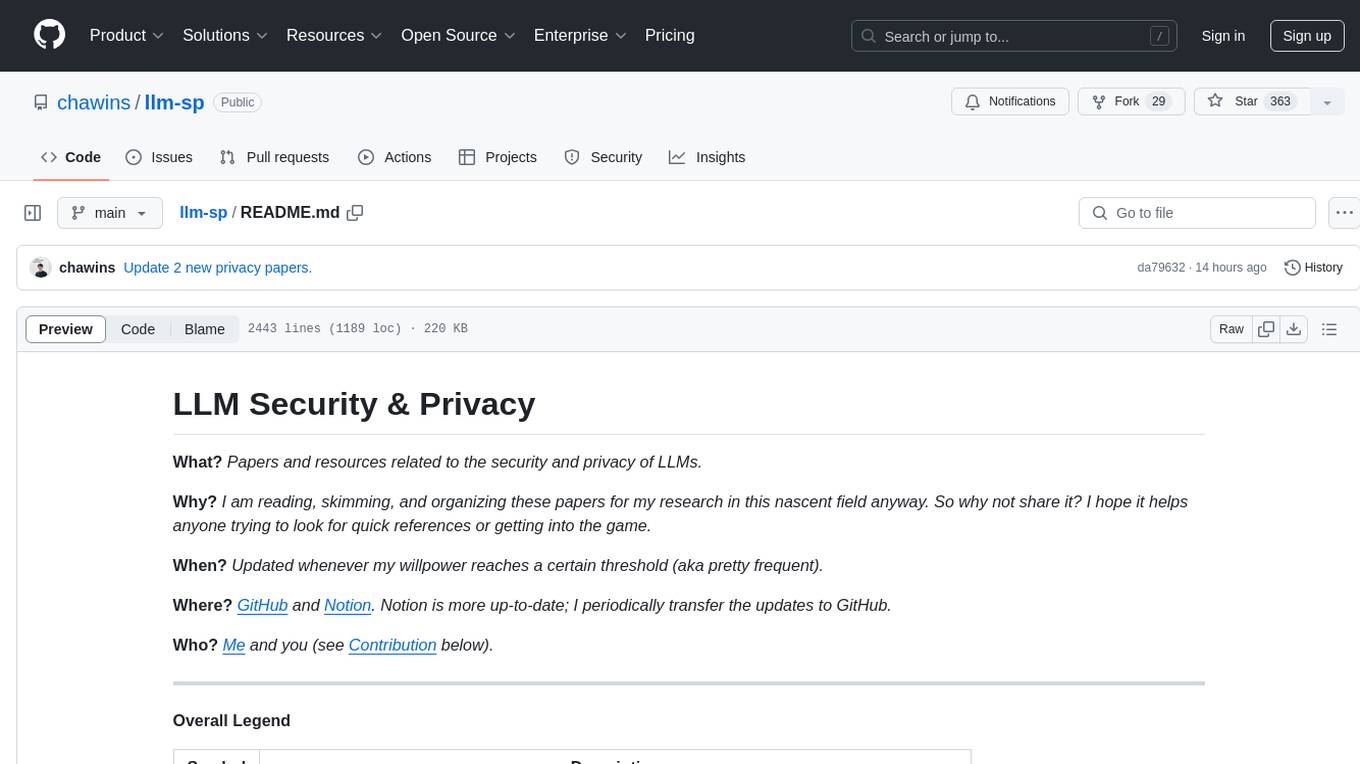
AI4Animation
Bringing Characters to Life with Computer Brains in Unity
Stars: 7538
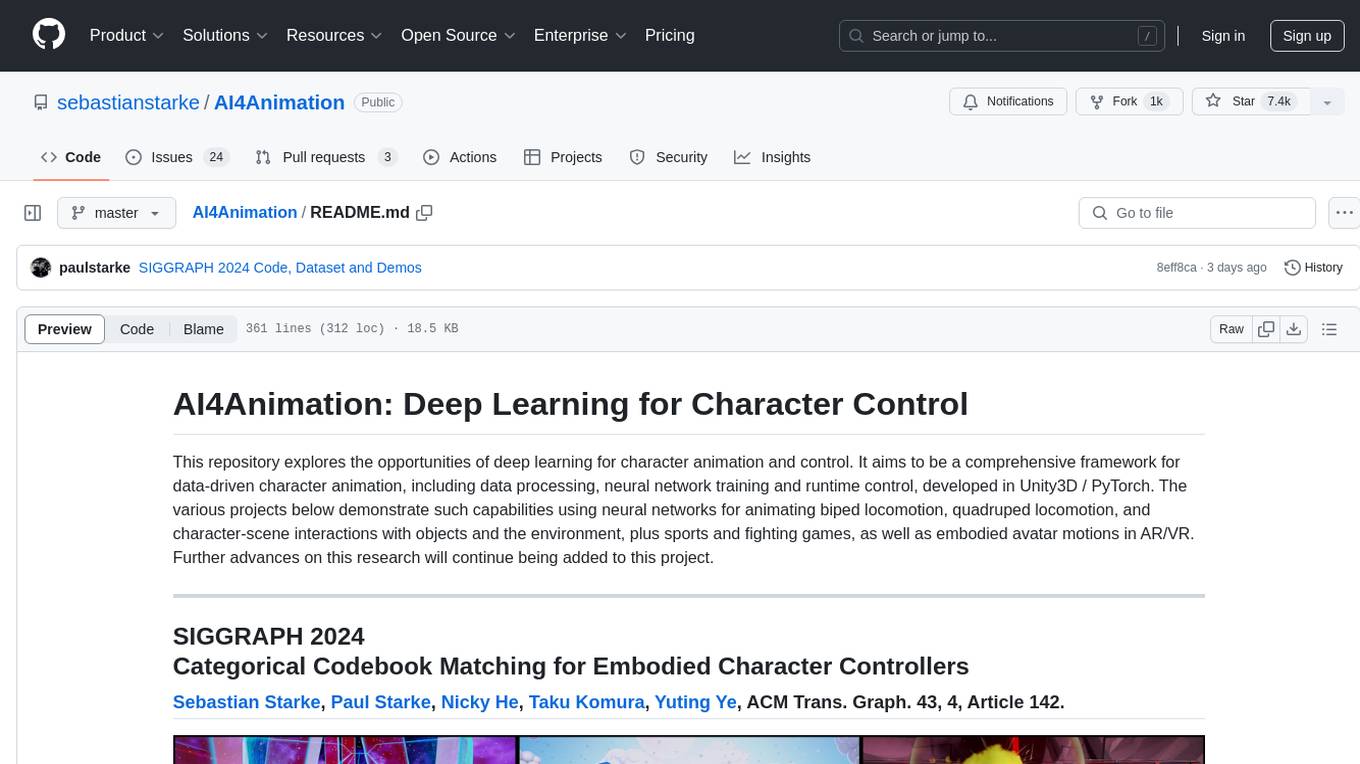
AI4Animation is a comprehensive framework for data-driven character animation, including data processing, neural network training, and runtime control, developed in Unity3D/PyTorch. It explores deep learning opportunities for character animation, covering biped and quadruped locomotion, character-scene interactions, sports and fighting games, and embodied avatar motions in AR/VR. The research focuses on generative frameworks, codebook matching, periodic autoencoders, animation layering, local motion phases, and neural state machines for character control and animation.
README:
This repository explores the opportunities of deep learning for character animation and control. It aims to be a comprehensive framework for data-driven character animation, including data processing, neural network training and runtime control, developed in Unity3D / PyTorch. The various projects below demonstrate such capabilities using neural networks for animating biped locomotion, quadruped locomotion, and character-scene interactions with objects and the environment, plus sports and fighting games, as well as embodied avatar motions in AR/VR. Further advances on this research will continue being added to this project.
SIGGRAPH 2024
Categorical Codebook Matching for Embodied Character Controllers
Sebastian Starke,
Paul Starke,
Nicky He,
Taku Komura,
Yuting Ye,
ACM Trans. Graph. 43, 4, Article 142.
Translating motions from a real user onto a virtual embodied avatar is a key challenge for character animation in the metaverse. In this work, we present a novel generative framework that enables mapping from a set of sparse sensor signals to a full body avatar motion in real-time while faithfully preserving the motion context of the user. In contrast to existing techniques that require training a motion prior and its mapping from control to motion separately, our framework is able to learn the motion manifold as well as how to sample from it at the same time in an end-to-end manner. To achieve that, we introduce a technique called codebook matching which matches the probability distribution between two categorical codebooks for the inputs and outputs for synthesizing the character motions. We demonstrate this technique can successfully handle ambiguity in motion generation and produce high quality character controllers from unstructured motion capture data. Our method is especially useful for interactive applications like virtual reality or video games where high accuracy and responsiveness are needed.
- Video - Paper - Dataset - Code (+VR Demo) - Windows Demo - Mac Demo - ReadMe -
Unlike existing methods for kinematic character control that learn a direct mapping between inputs and outputs or utilize a motion prior that is trained on the motion data alone, our framework learns from both the inputs and outputs simultaneously to form a motion manifold that is informed about the control signals. To learn such setup in a supervised manner, we propose a technique that we call Codebook Matching which enforces similarity between both latent probability distributions $Z_𝑋$ and $Z_𝑌$. In the context of motion generation, instead of directly predicting the motions outputs from the control inputs, we only predict their probabilities for each of them to appear. By introducing a matching loss between both categorical probability distributions, our codebook matching technique allows to substitute $Z_𝑌$ by $Z_𝑋$ during test time.
Training:
\begin{cases}
Y \rightarrow Z_Y \rightarrow Y
\\
X \rightarrow Z_X
\\
Z_X \sim Z_Y
\end{cases}
Inference:
X \rightarrow Z_X \rightarrow Y
Our method is not limited to three-point inputs but we can also use it to generate embodied character movements with additional joystick or button controls by what we call hybrid control mode. In this setting, the user, engineer or artist can additionally tell the character where to go via a simple goal location while preserving the original context of motion from three-point tracking signals. This changes the scope of applications we can address by walking / running / crouching in the virtual world while standing or even sitting in the real world.
Furthermore, our codebook matching architecture shares many similarities with motion matching and is able to learn a similar structure in an end-to-end manner. While motion matching can bypass ambiguity in the mapping from control to motion by selecting among candidates with similar query distances, our setup selects possible outcomes from predicted probabilities and naturally projects against valid output motions if their probabilities are similar. However, in contrast to database searches, our codebook matching is able to effectively compress the motion data where same motions map to same codes, and can bypass ambiguity issues which existing learning-based methods such as standard feed-forward networks (MLP) or variational models (CVAE) may struggle with. We demonstrate such capabilities by reconstructing the ambiguous toy example functions in the figure below.
SIGGRAPH 2022
DeepPhase: Periodic Autoencoders for Learning Motion Phase Manifolds
Sebastian Starke,
Ian Mason,
Taku Komura,
ACM Trans. Graph. 41, 4, Article 136.
Learning the spatial-temporal structure of body movements is a fundamental problem for character motion synthesis. In this work, we propose a novel neural network architecture called the Periodic Autoencoder that can learn periodic features from large unstructured motion datasets in an unsupervised manner. The character movements are decomposed into multiple latent channels that capture the non-linear periodicity of different body segments while progressing forward in time. Our method extracts a multi-dimensional phase space from full-body motion data, which effectively clusters animations and produces a manifold in which computed feature distances provide a better similarity measure than in the original motion space to achieve better temporal and spatial alignment. We demonstrate that the learned periodic embedding can significantly help to improve neural motion synthesis in a number of tasks, including diverse locomotion skills, style-based movements, dance motion synthesis from music, synthesis of dribbling motions in football, and motion query for matching poses within large animation databases.
- Video - Paper - PAE Code & Demo - Animation Code & Demo - Explanation and Addendum - Tutorial -
- Motion In-Betweening System -
SIGGRAPH 2021
Neural Animation Layering for Synthesizing Martial Arts Movements
Sebastian Starke,
Yiwei Zhao,
Fabio Zinno,
Taku Komura,
ACM Trans. Graph. 40, 4, Article 92.
Interactively synthesizing novel combinations and variations of character movements from different motion skills is a key problem in computer animation. In this research, we propose a deep learning framework to produce a large variety of martial arts movements in a controllable manner from raw motion capture data. Our method imitates animation layering using neural networks with the aim to overcome typical challenges when mixing, blending and editing movements from unaligned motion sources. The system can be used for offline and online motion generation alike, provides an intuitive interface to integrate with animator workflows, and is relevant for real-time applications such as computer games.
SIGGRAPH 2020
Local Motion Phases for Learning Multi-Contact Character Movements
Sebastian Starke,
Yiwei Zhao,
Taku Komura,
Kazi Zaman.
ACM Trans. Graph. 39, 4, Article 54.
Not sure how to align complex character movements? Tired of phase labeling? Unclear how to squeeze everything into a single phase variable? Don't worry, a solution exists!
Controlling characters to perform a large variety of dynamic, fast-paced and quickly changing movements is a key challenge in character animation. In this research, we present a deep learning framework to interactively synthesize such animations in high quality, both from unstructured motion data and without any manual labeling. We introduce the concept of local motion phases, and show our system being able to produce various motion skills, such as ball dribbling and professional maneuvers in basketball plays, shooting, catching, avoidance, multiple locomotion modes as well as different character and object interactions, all generated under a unified framework.
- Video - Paper - Code - Windows Demo - ReadMe -
SIGGRAPH Asia 2019
Neural State Machine for Character-Scene Interactions
Sebastian Starke+,
He Zhang+,
Taku Komura,
Jun Saito.
ACM Trans. Graph. 38, 6, Article 178.
(+Joint First Authors)
Animating characters can be an easy or difficult task - interacting with objects is one of the latter. In this research, we present the Neural State Machine, a data-driven deep learning framework for character-scene interactions. The difficulty in such animations is that they require complex planning of periodic as well as aperiodic movements to complete a given task. Creating them in a production-ready quality is not straightforward and often very time-consuming. Instead, our system can synthesize different movements and scene interactions from motion capture data, and allows the user to seamlessly control the character in real-time from simple control commands. Since our model directly learns from the geometry, the motions can naturally adapt to variations in the scene. We show that our system can generate a large variety of movements, icluding locomotion, sitting on chairs, carrying boxes, opening doors and avoiding obstacles, all from a single model. The model is responsive, compact and scalable, and is the first of such frameworks to handle scene interaction tasks for data-driven character animation.
- Video - Paper - Code & Demo - Mocap Data - ReadMe -
SIGGRAPH 2018
Mode-Adaptive Neural Networks for Quadruped Motion Control
He Zhang+,
Sebastian Starke+,
Taku Komura,
Jun Saito.
ACM Trans. Graph. 37, 4, Article 145.
(+Joint First Authors)
Animating characters can be a pain, especially those four-legged monsters! This year, we will be presenting our recent research on quadruped animation and character control at the SIGGRAPH 2018 in Vancouver. The system can produce natural animations from real motion data using a novel neural network architecture, called Mode-Adaptive Neural Networks. Instead of optimising a fixed group of weights, the system learns to dynamically blend a group of weights into a further neural network, based on the current state of the character. That said, the system does not require labels for the phase or locomotion gaits, but can learn from unstructured motion capture data in an end-to-end fashion.
- Video - Paper - Code - Mocap Data - Windows Demo - Linux Demo - Mac Demo - ReadMe -
SIGGRAPH 2017
Phase-Functioned Neural Networks for Character Control
Daniel Holden,
Taku Komura,
Jun Saito.
ACM Trans. Graph. 36, 4, Article 42.
This work continues the recent work on PFNN (Phase-Functioned Neural Networks) for character control. A demo in Unity3D using the original weights for terrain-adaptive locomotion is contained in the Assets/Demo/SIGGRAPH_2017/Original folder. Another demo on flat ground using the Adam character is contained in the Assets/Demo/SIGGRAPH_2017/Adam folder. In order to run them, you need to download the neural network weights from the link provided in the Link.txt file, extract them into the /NN folder, and store the parameters via the custom inspector button.
- Video - Paper - Code (Unity) - Windows Demo - Linux Demo - Mac Demo -
This project is only for research or education purposes, and not freely available for commercial use or redistribution. The motion capture data is available only under the terms of the Attribution-NonCommercial 4.0 International (CC BY-NC 4.0) license.
For Tasks:
Click tags to check more tools for each tasksFor Jobs:
Alternative AI tools for AI4Animation
Similar Open Source Tools

AI4Animation
AI4Animation is a comprehensive framework for data-driven character animation, including data processing, neural network training, and runtime control, developed in Unity3D/PyTorch. It explores deep learning opportunities for character animation, covering biped and quadruped locomotion, character-scene interactions, sports and fighting games, and embodied avatar motions in AR/VR. The research focuses on generative frameworks, codebook matching, periodic autoencoders, animation layering, local motion phases, and neural state machines for character control and animation.
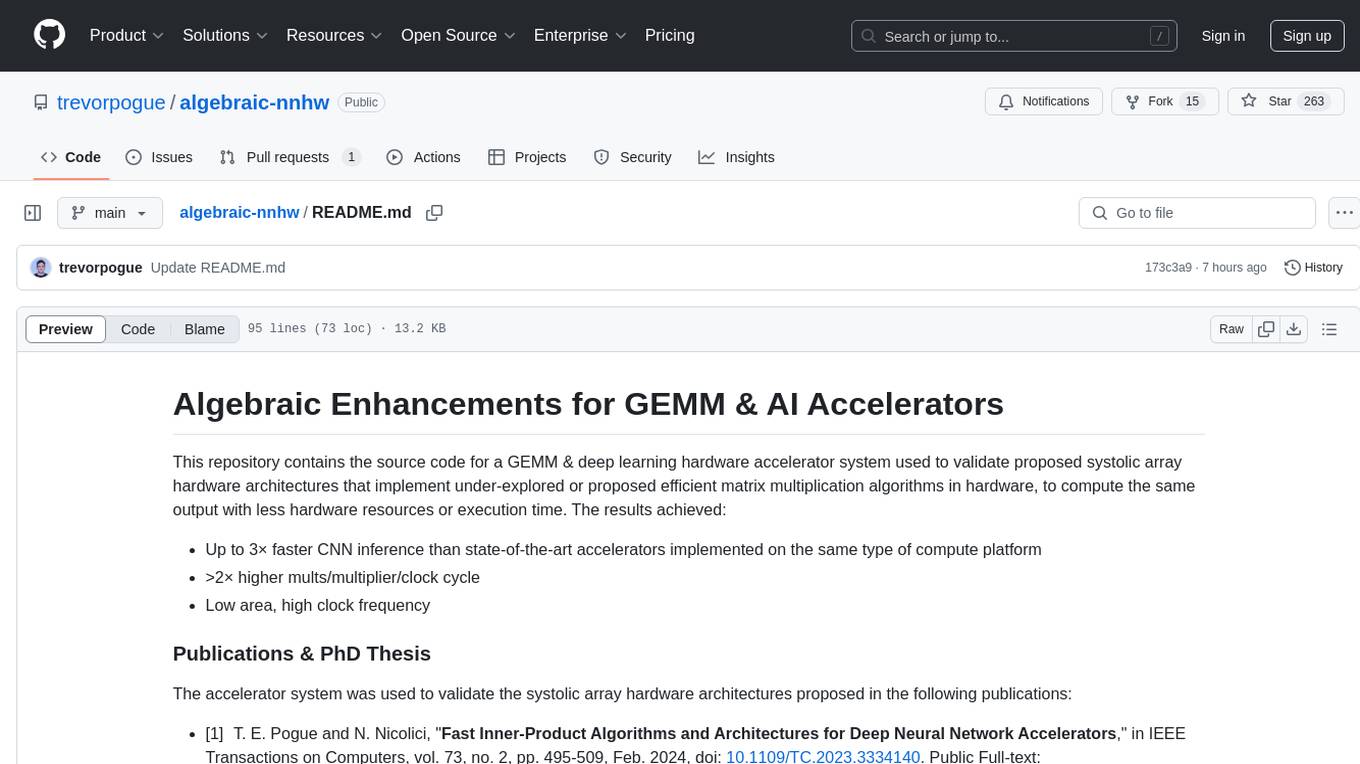
algebraic-nnhw
This repository contains the source code for a GEMM & deep learning hardware accelerator system used to validate proposed systolic array hardware architectures implementing efficient matrix multiplication algorithms to increase performance-per-area limits of GEMM & AI accelerators. Achieved results include up to 3× faster CNN inference, >2× higher mults/multiplier/clock cycle, and low area with high clock frequency. The system is specialized for inference of non-sparse DNN models with fixed-point/quantized inputs, fully accelerating all DNN layers in hardware, and highly optimizing GEMM acceleration.
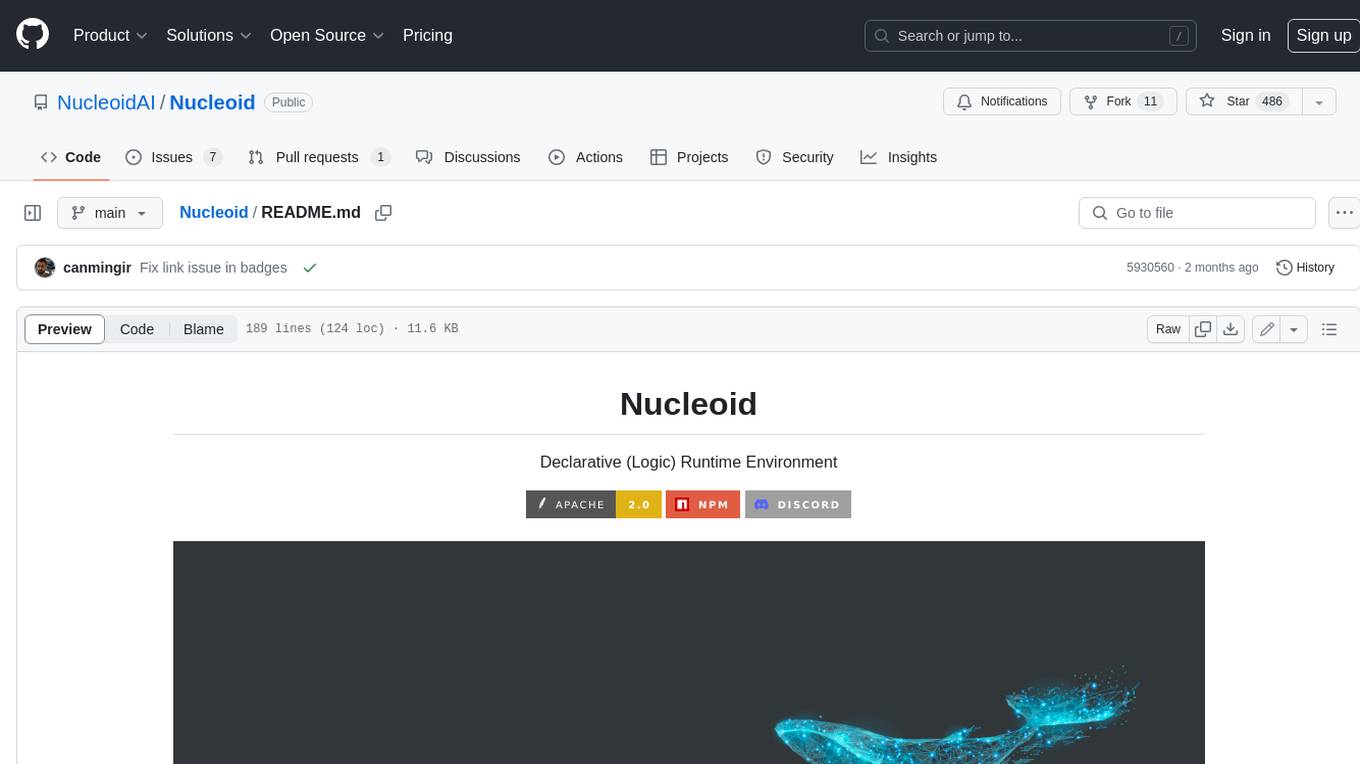
Nucleoid
Nucleoid is a declarative (logic) runtime environment that manages both data and logic under the same runtime. It uses a declarative programming paradigm, which allows developers to focus on the business logic of the application, while the runtime manages the technical details. This allows for faster development and reduces the amount of code that needs to be written. Additionally, the sharding feature can help to distribute the load across multiple instances, which can further improve the performance of the system.
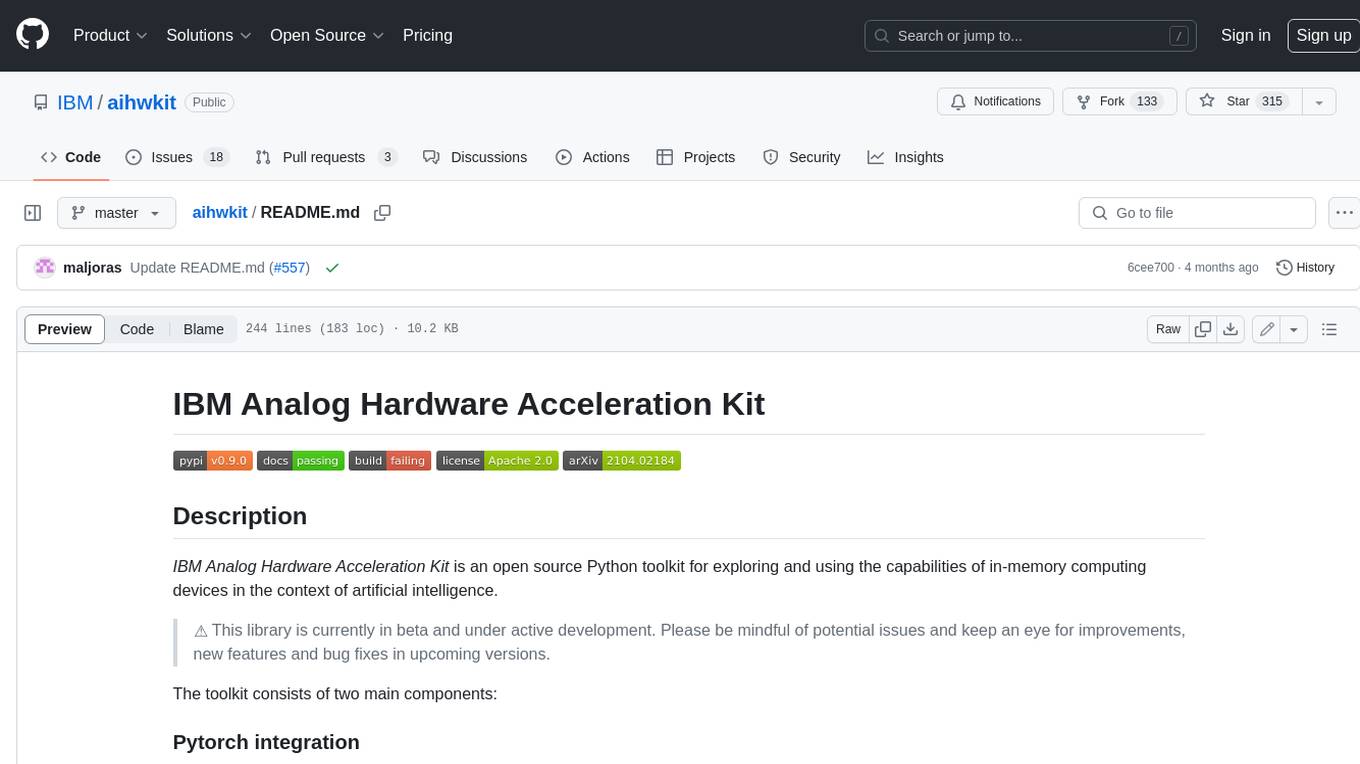
aihwkit
The IBM Analog Hardware Acceleration Kit is an open-source Python toolkit for exploring and using the capabilities of in-memory computing devices in the context of artificial intelligence. It consists of two main components: Pytorch integration and Analog devices simulator. The Pytorch integration provides a series of primitives and features that allow using the toolkit within PyTorch, including analog neural network modules, analog training using torch training workflow, and analog inference using torch inference workflow. The Analog devices simulator is a high-performant (CUDA-capable) C++ simulator that allows for simulating a wide range of analog devices and crossbar configurations by using abstract functional models of material characteristics with adjustable parameters. Along with the two main components, the toolkit includes other functionalities such as a library of device presets, a module for executing high-level use cases, a utility to automatically convert a downloaded model to its equivalent Analog model, and integration with the AIHW Composer platform. The toolkit is currently in beta and under active development, and users are advised to be mindful of potential issues and keep an eye for improvements, new features, and bug fixes in upcoming versions.
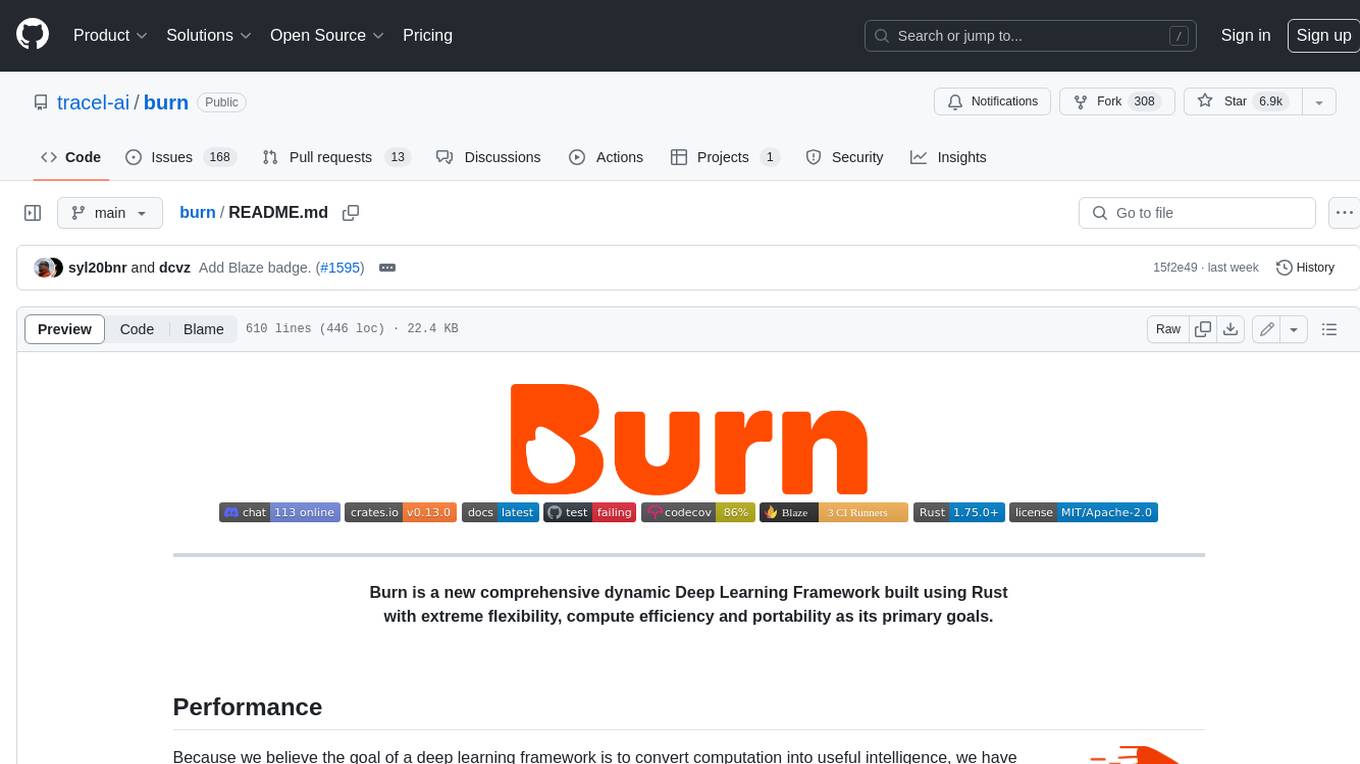
burn
Burn is a new comprehensive dynamic Deep Learning Framework built using Rust with extreme flexibility, compute efficiency and portability as its primary goals.
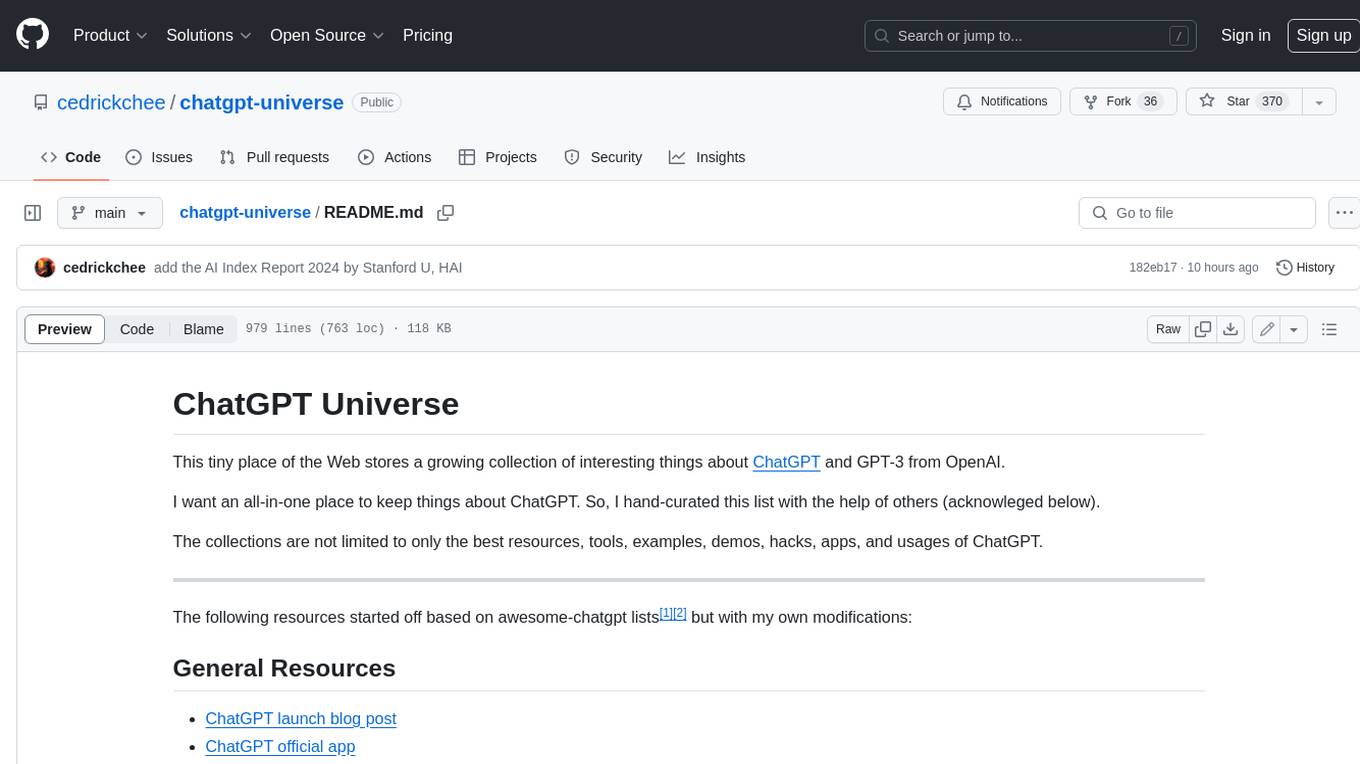
chatgpt-universe
ChatGPT is a large language model that can generate human-like text, translate languages, write different kinds of creative content, and answer your questions in a conversational way. It is trained on a massive amount of text data, and it is able to understand and respond to a wide range of natural language prompts. Here are 5 jobs suitable for this tool, in lowercase letters: 1. content writer 2. chatbot assistant 3. language translator 4. creative writer 5. researcher
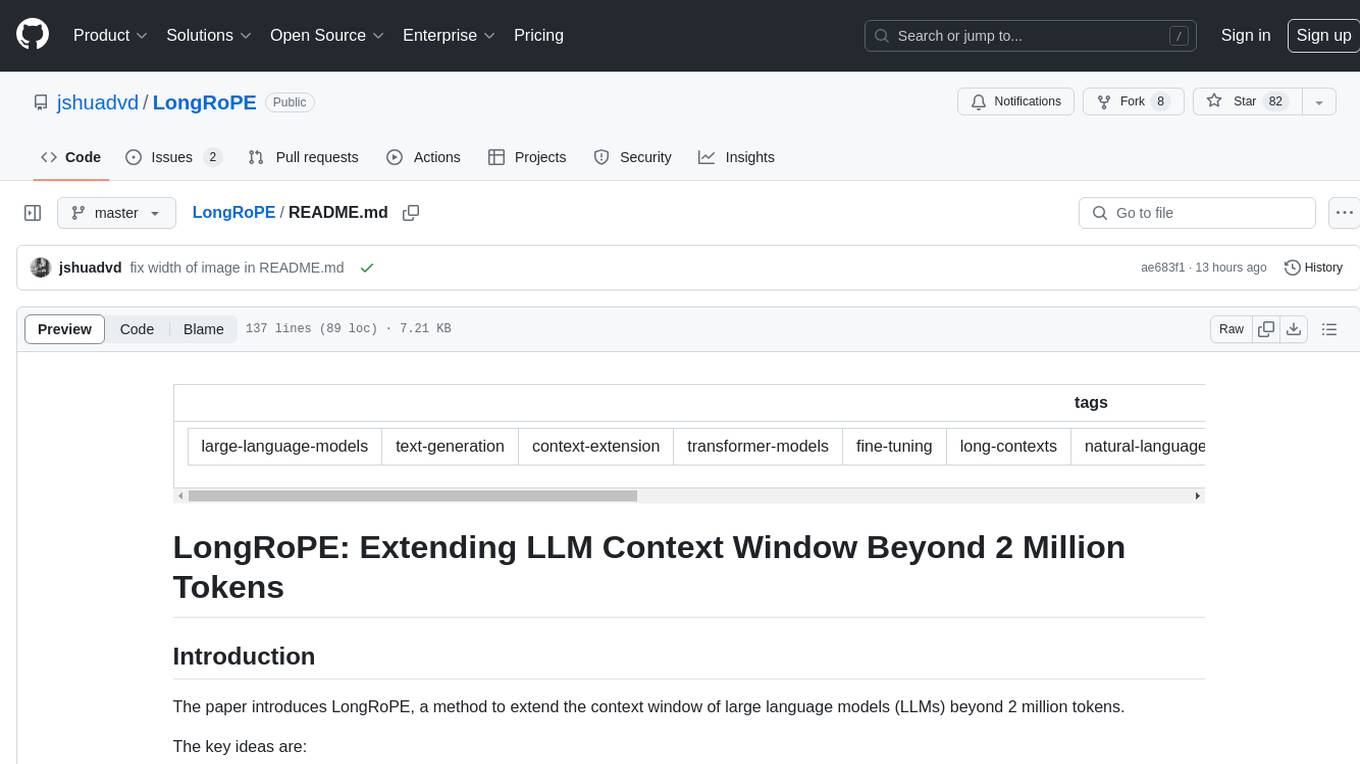
LongRoPE
LongRoPE is a method to extend the context window of large language models (LLMs) beyond 2 million tokens. It identifies and exploits non-uniformities in positional embeddings to enable 8x context extension without fine-tuning. The method utilizes a progressive extension strategy with 256k fine-tuning to reach a 2048k context. It adjusts embeddings for shorter contexts to maintain performance within the original window size. LongRoPE has been shown to be effective in maintaining performance across various tasks from 4k to 2048k context lengths.

Raspberry
Raspberry is an open source project aimed at creating a toy dataset for finetuning Large Language Models (LLMs) with reasoning abilities. The project involves synthesizing complex user queries across various domains, generating CoT and Self-Critique data, cleaning and rectifying samples, finetuning an LLM with the dataset, and seeking funding for scalability. The ultimate goal is to develop a dataset that challenges models with tasks requiring math, coding, logic, reasoning, and planning skills, spanning different sectors like medicine, science, and software development.
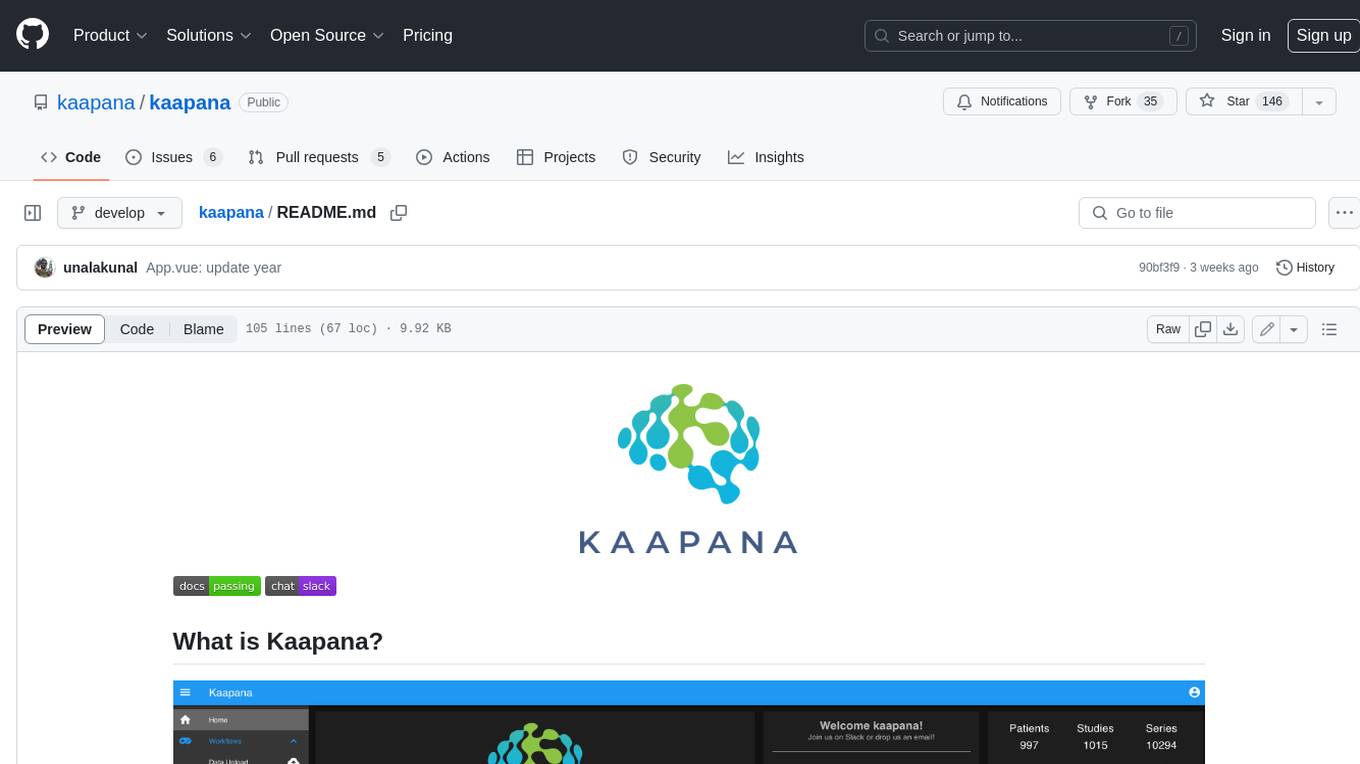
kaapana
Kaapana is an open-source toolkit for state-of-the-art platform provisioning in the field of medical data analysis. The applications comprise AI-based workflows and federated learning scenarios with a focus on radiological and radiotherapeutic imaging. Obtaining large amounts of medical data necessary for developing and training modern machine learning methods is an extremely challenging effort that often fails in a multi-center setting, e.g. due to technical, organizational and legal hurdles. A federated approach where the data remains under the authority of the individual institutions and is only processed on-site is, in contrast, a promising approach ideally suited to overcome these difficulties. Following this federated concept, the goal of Kaapana is to provide a framework and a set of tools for sharing data processing algorithms, for standardized workflow design and execution as well as for performing distributed method development. This will facilitate data analysis in a compliant way enabling researchers and clinicians to perform large-scale multi-center studies. By adhering to established standards and by adopting widely used open technologies for private cloud development and containerized data processing, Kaapana integrates seamlessly with the existing clinical IT infrastructure, such as the Picture Archiving and Communication System (PACS), and ensures modularity and easy extensibility.
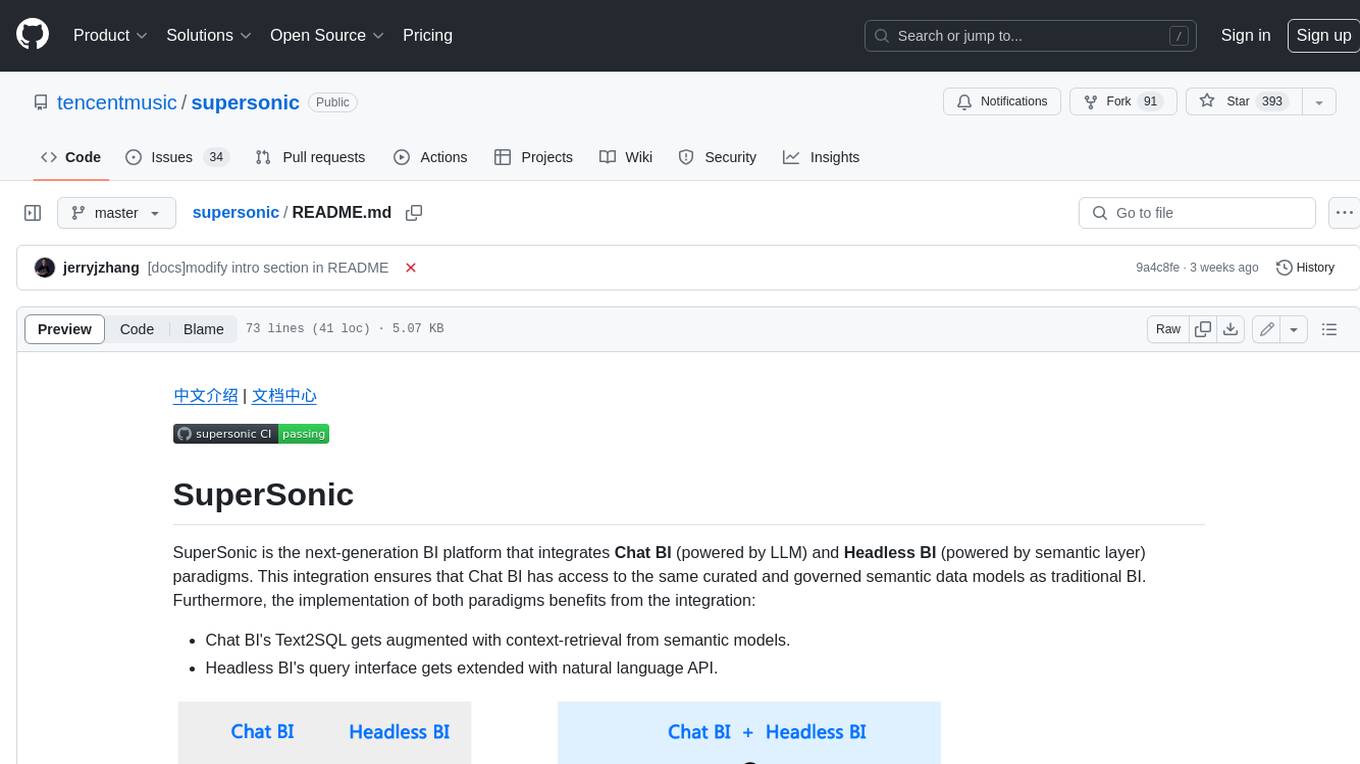
supersonic
SuperSonic is a next-generation BI platform that integrates Chat BI (powered by LLM) and Headless BI (powered by semantic layer) paradigms. This integration ensures that Chat BI has access to the same curated and governed semantic data models as traditional BI. Furthermore, the implementation of both paradigms benefits from the integration: * Chat BI's Text2SQL gets augmented with context-retrieval from semantic models. * Headless BI's query interface gets extended with natural language API. SuperSonic provides a Chat BI interface that empowers users to query data using natural language and visualize the results with suitable charts. To enable such experience, the only thing necessary is to build logical semantic models (definition of metric/dimension/tag, along with their meaning and relationships) through a Headless BI interface. Meanwhile, SuperSonic is designed to be extensible and composable, allowing custom implementations to be added and configured with Java SPI. The integration of Chat BI and Headless BI has the potential to enhance the Text2SQL generation in two dimensions: 1. Incorporate data semantics (such as business terms, column values, etc.) into the prompt, enabling LLM to better understand the semantics and reduce hallucination. 2. Offload the generation of advanced SQL syntax (such as join, formula, etc.) from LLM to the semantic layer to reduce complexity. With these ideas in mind, we develop SuperSonic as a practical reference implementation and use it to power our real-world products. Additionally, to facilitate further development we decide to open source SuperSonic as an extensible framework.
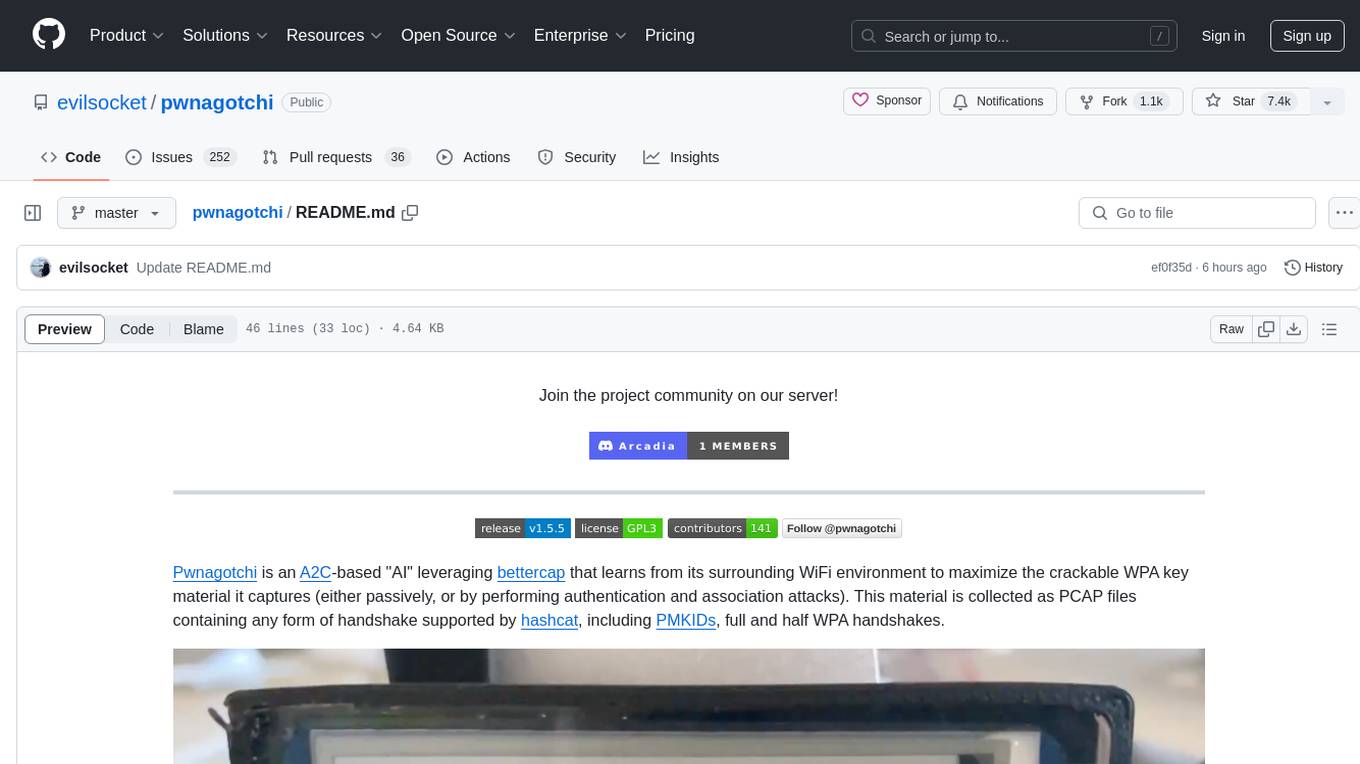
pwnagotchi
Pwnagotchi is an AI tool leveraging bettercap to learn from WiFi environments and maximize crackable WPA key material. It uses LSTM with MLP feature extractor for A2C agent, learning over epochs to improve performance in various WiFi environments. Units can cooperate using a custom parasite protocol. Visit https://www.pwnagotchi.ai for documentation and community links.
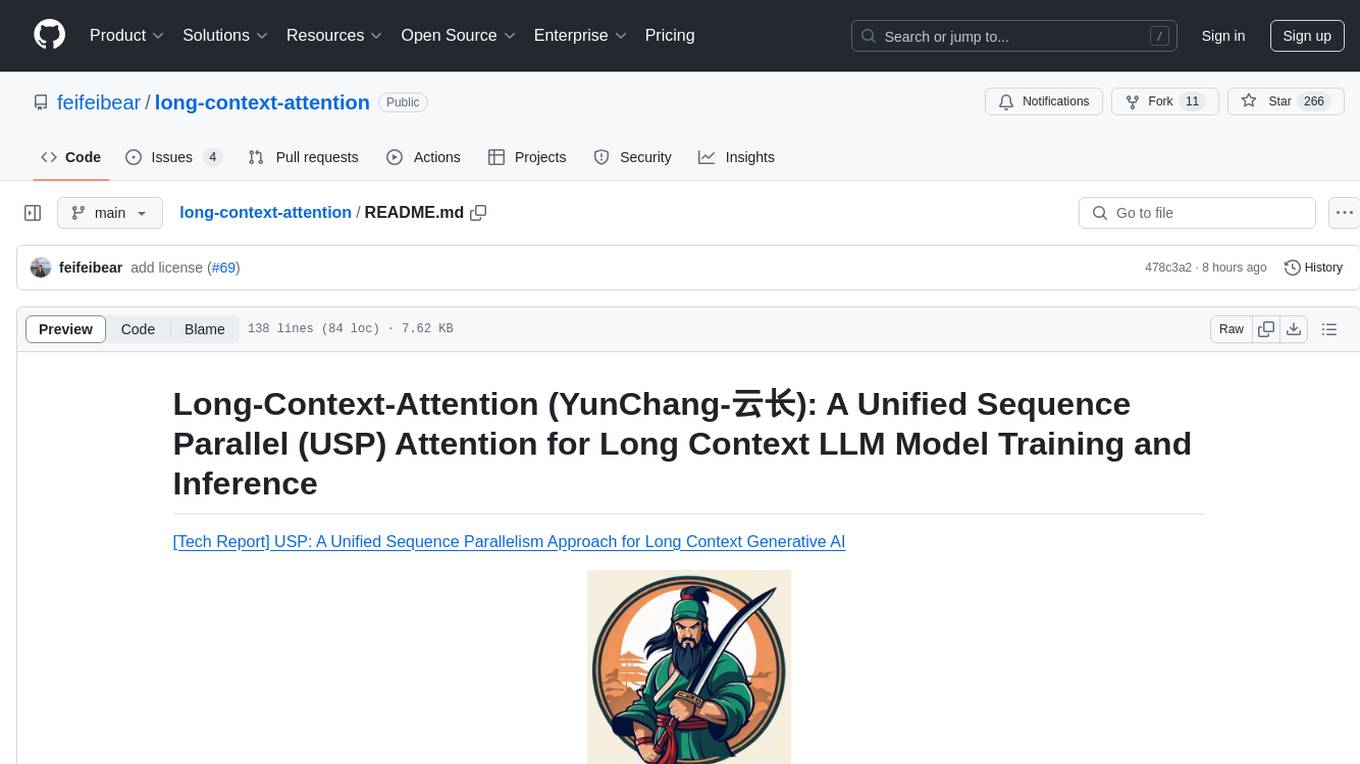
long-context-attention
Long-Context-Attention (YunChang) is a unified sequence parallel approach that combines the strengths of DeepSpeed-Ulysses-Attention and Ring-Attention to provide a versatile and high-performance solution for long context LLM model training and inference. It addresses the limitations of both methods by offering no limitation on the number of heads, compatibility with advanced parallel strategies, and enhanced performance benchmarks. The tool is verified in Megatron-LM and offers best practices for 4D parallelism, making it suitable for various attention mechanisms and parallel computing advancements.
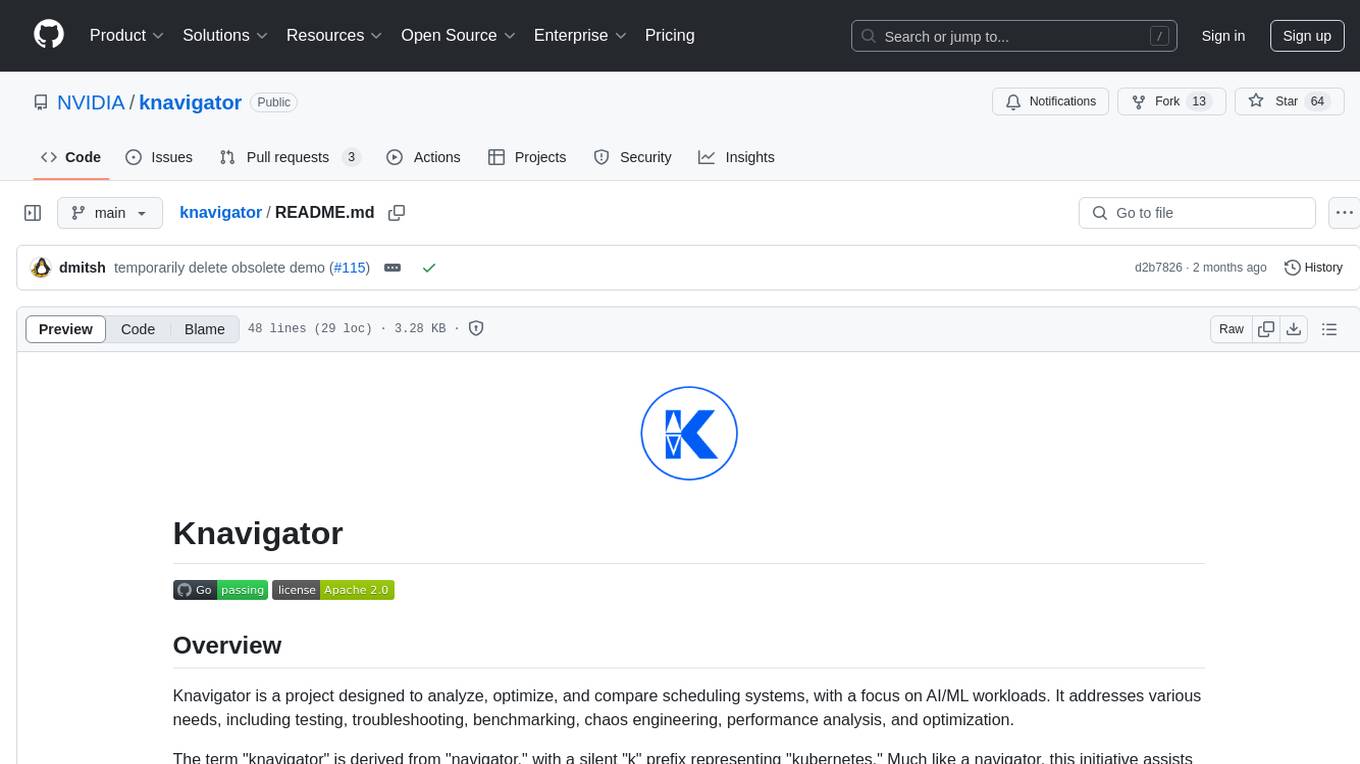
knavigator
Knavigator is a project designed to analyze, optimize, and compare scheduling systems, with a focus on AI/ML workloads. It addresses various needs, including testing, troubleshooting, benchmarking, chaos engineering, performance analysis, and optimization. Knavigator interfaces with Kubernetes clusters to manage tasks such as manipulating with Kubernetes objects, evaluating PromQL queries, as well as executing specific operations. It can operate both outside and inside a Kubernetes cluster, leveraging the Kubernetes API for task management. To facilitate large-scale experiments without the overhead of running actual user workloads, Knavigator utilizes KWOK for creating virtual nodes in extensive clusters.
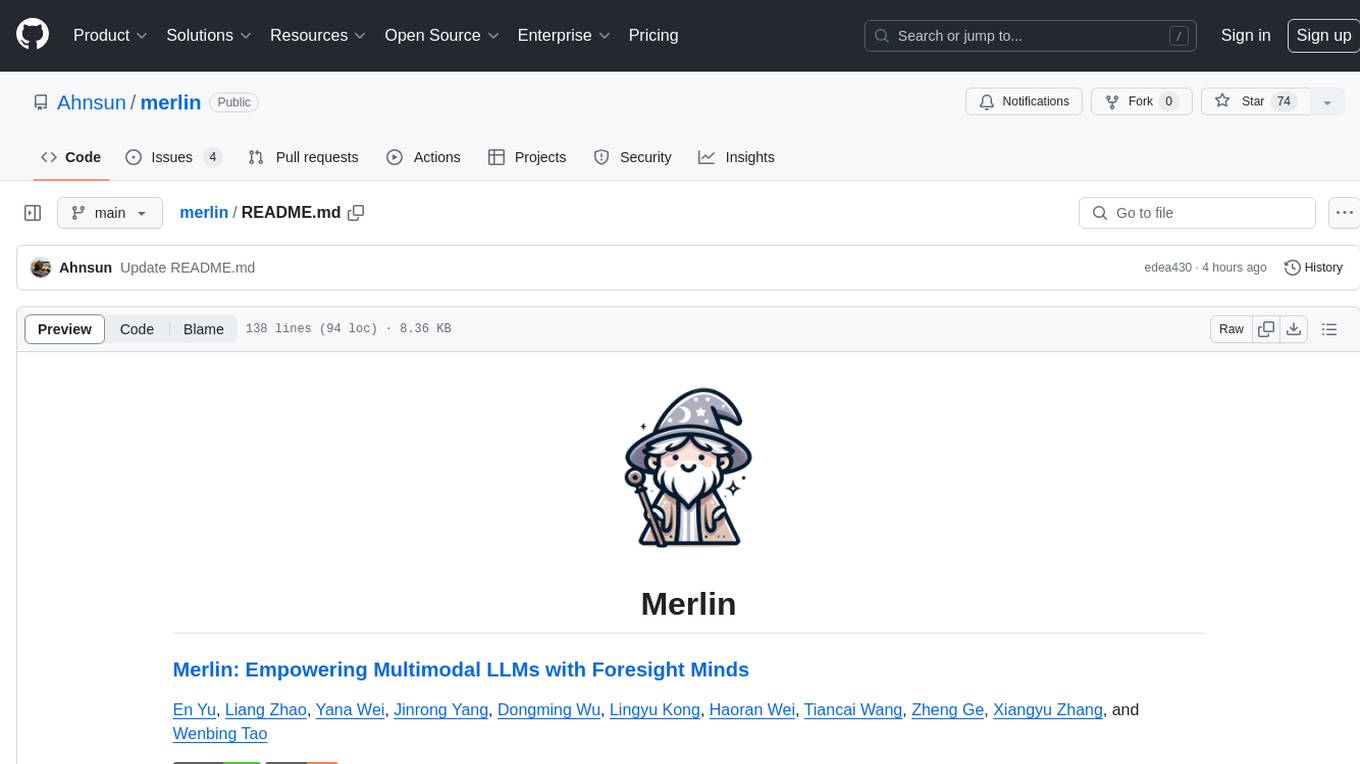
merlin
Merlin is a groundbreaking model capable of generating natural language responses intricately linked with object trajectories of multiple images. It excels in predicting and reasoning about future events based on initial observations, showcasing unprecedented capability in future prediction and reasoning. Merlin achieves state-of-the-art performance on the Future Reasoning Benchmark and multiple existing multimodal language models benchmarks, demonstrating powerful multi-modal general ability and foresight minds.
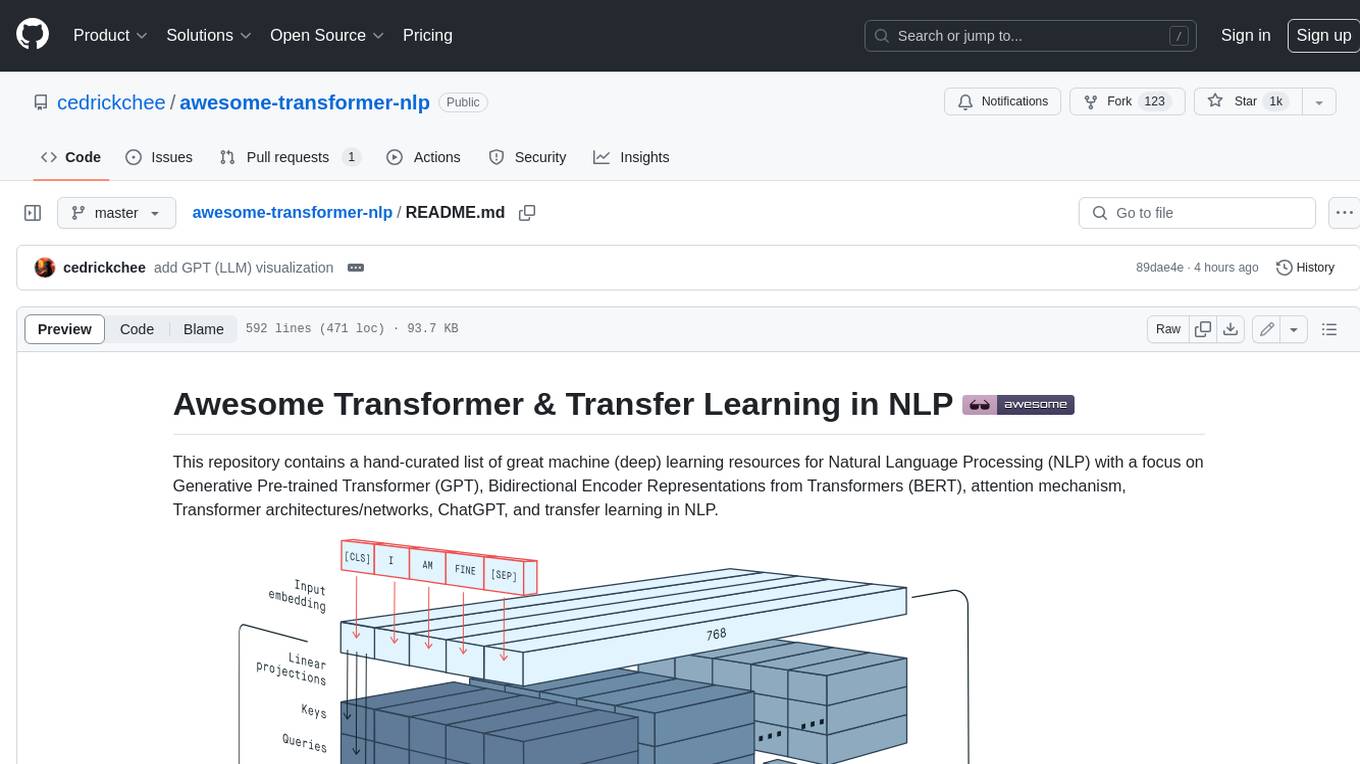
awesome-transformer-nlp
This repository contains a hand-curated list of great machine (deep) learning resources for Natural Language Processing (NLP) with a focus on Generative Pre-trained Transformer (GPT), Bidirectional Encoder Representations from Transformers (BERT), attention mechanism, Transformer architectures/networks, Chatbot, and transfer learning in NLP.
For similar tasks

AI4Animation
AI4Animation is a comprehensive framework for data-driven character animation, including data processing, neural network training, and runtime control, developed in Unity3D/PyTorch. It explores deep learning opportunities for character animation, covering biped and quadruped locomotion, character-scene interactions, sports and fighting games, and embodied avatar motions in AR/VR. The research focuses on generative frameworks, codebook matching, periodic autoencoders, animation layering, local motion phases, and neural state machines for character control and animation.
For similar jobs

sweep
Sweep is an AI junior developer that turns bugs and feature requests into code changes. It automatically handles developer experience improvements like adding type hints and improving test coverage.

teams-ai
The Teams AI Library is a software development kit (SDK) that helps developers create bots that can interact with Teams and Microsoft 365 applications. It is built on top of the Bot Framework SDK and simplifies the process of developing bots that interact with Teams' artificial intelligence capabilities. The SDK is available for JavaScript/TypeScript, .NET, and Python.

ai-guide
This guide is dedicated to Large Language Models (LLMs) that you can run on your home computer. It assumes your PC is a lower-end, non-gaming setup.

classifai
Supercharge WordPress Content Workflows and Engagement with Artificial Intelligence. Tap into leading cloud-based services like OpenAI, Microsoft Azure AI, Google Gemini and IBM Watson to augment your WordPress-powered websites. Publish content faster while improving SEO performance and increasing audience engagement. ClassifAI integrates Artificial Intelligence and Machine Learning technologies to lighten your workload and eliminate tedious tasks, giving you more time to create original content that matters.

chatbot-ui
Chatbot UI is an open-source AI chat app that allows users to create and deploy their own AI chatbots. It is easy to use and can be customized to fit any need. Chatbot UI is perfect for businesses, developers, and anyone who wants to create a chatbot.

BricksLLM
BricksLLM is a cloud native AI gateway written in Go. Currently, it provides native support for OpenAI, Anthropic, Azure OpenAI and vLLM. BricksLLM aims to provide enterprise level infrastructure that can power any LLM production use cases. Here are some use cases for BricksLLM: * Set LLM usage limits for users on different pricing tiers * Track LLM usage on a per user and per organization basis * Block or redact requests containing PIIs * Improve LLM reliability with failovers, retries and caching * Distribute API keys with rate limits and cost limits for internal development/production use cases * Distribute API keys with rate limits and cost limits for students

uAgents
uAgents is a Python library developed by Fetch.ai that allows for the creation of autonomous AI agents. These agents can perform various tasks on a schedule or take action on various events. uAgents are easy to create and manage, and they are connected to a fast-growing network of other uAgents. They are also secure, with cryptographically secured messages and wallets.

griptape
Griptape is a modular Python framework for building AI-powered applications that securely connect to your enterprise data and APIs. It offers developers the ability to maintain control and flexibility at every step. Griptape's core components include Structures (Agents, Pipelines, and Workflows), Tasks, Tools, Memory (Conversation Memory, Task Memory, and Meta Memory), Drivers (Prompt and Embedding Drivers, Vector Store Drivers, Image Generation Drivers, Image Query Drivers, SQL Drivers, Web Scraper Drivers, and Conversation Memory Drivers), Engines (Query Engines, Extraction Engines, Summary Engines, Image Generation Engines, and Image Query Engines), and additional components (Rulesets, Loaders, Artifacts, Chunkers, and Tokenizers). Griptape enables developers to create AI-powered applications with ease and efficiency.
























